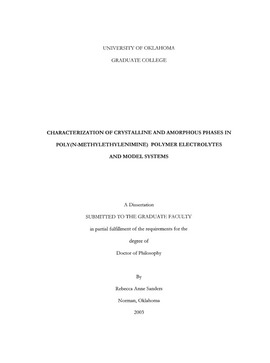| dc.contributor.advisor | Frech, Roger, | en_US |
| dc.contributor.author | Sanders, Rebecca Anne. | en_US |
| dc.date.accessioned | 2013-08-16T12:19:03Z | |
| dc.date.available | 2013-08-16T12:19:03Z | |
| dc.date.issued | 2003 | en_US |
| dc.identifier.uri | https://hdl.handle.net/11244/634 | |
| dc.description.abstract | LPEI is analogous to PEO, except LPEI has a heteroatom that is synthetically versatile because different side groups can be readily attached. LPEI:salt systems are not well understood as polymer electrolytes. Therefore, N, N '-dimethylethylenediamine (DMEDA) complexed with NaCF3 SO3 (NaTf) was investigated in this dissertation as a model compound for LPEI, in order to gain further insight into hydrogen bonding in amine systems. While studying DMEDA:NaTf, single crystals were discovered and characterized with infrared and Raman spectroscopy, X-ray diffraction, and differential scanning calorimetry (DSC). In DMEDA:NaTf solutions, there is evidence of local structures similar to that in crystalline DMEDA:NaTf based on infrared and Raman spectroscopy data. | en_US |
| dc.description.abstract | Polymer electrolytes have been investigated as ionic conductors in rechargeable lithium batteries. Poly(ethylene oxide):salt systems are the most widely investigated polymer electrolytes. However, the conductivity values for these system are not sufficiently high to be useful for practical lithium batteries. Therefore, other polymer electrolytes are being explored such as linear poly(ethylenimine), LPEI, and linear poly(N-methylethylenimine), LPMEI. | en_US |
| dc.description.abstract | LPMEI is a derivative of LPEI. LPMEI is amorphous at room temperature unlike LPEI, which melts at 58° C. Because there is a limited amount of information reported about LPMEI as polymer electrolytes, this dissertation characterizes LPMEI complexed with LiTf and NaTf utilizing IR, differential scanning calorimetry (DSC), powder X-ray diffraction, and complex impedance. To gain further insight into LPMEI systems, model systems were investigated such as N, N, N', N'-tetramethylethylenediamine (TMEDA) and N, N, N', N', N' -pentamethyldiethylenetriamine (PMDETA) complexed with LiTf and NaTf. When studying these model systems, crystalline compounds were discovered and characterized utilizing X-ray diffraction, DSC, IR, and Raman spectroscopy. The local structures in crystalline TMEDA:LiTf, TMEDA:NaTf, and PMDETA:NaTf can be correlated to these samples in solution, which provides greater insight into the local environment of the LPMEI:salt systems. | en_US |
| dc.format.extent | x, 119 leaves : | en_US |
| dc.subject | Hydrogen bonding. | en_US |
| dc.subject | Chemistry, Polymer. | en_US |
| dc.subject | Electrolytes Conductivity. | en_US |
| dc.subject | Chemistry, Physical. | en_US |
| dc.subject | Polyelectrolytes. | en_US |
| dc.subject | Lithium cells. | en_US |
| dc.title | Characterization of crystalline and amorphous phases in poly(N-methylethylenimine) polymer electrolytes and model systems. | en_US |
| dc.type | Thesis | en_US |
| dc.thesis.degree | Ph.D. | en_US |
| dc.thesis.degreeDiscipline | Department of Chemistry and Biochemistry | en_US |
| dc.note | Adviser: Roger Frech. | en_US |
| dc.note | Source: Dissertation Abstracts International, Volume: 64-08, Section: B, page: 3841. | en_US |
| ou.identifier | (UMI)AAI3102430 | en_US |
| ou.group | College of Arts and Sciences::Department of Chemistry and Biochemistry | |
